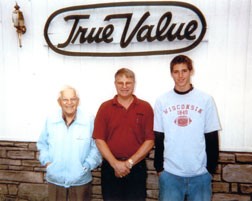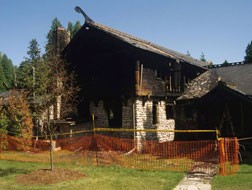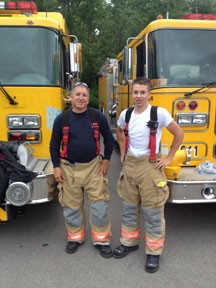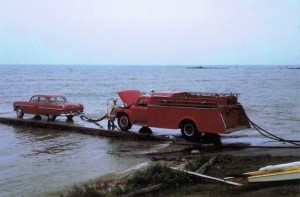Bucket Brigade to Rescue Boat
- Share
- Tweet
- Pin
- Share
On May 22, 1868, passengers on a ship in Lake Michigan, noting a raging fire on shore, reported, “Baileys Harbor is gone.” The town did lose four houses, two barns, a cooper shop, dozens of cords of wood and acres of wheat. Had it not been for a providential rain, the mistaken conclusion of those aboard the ship would likely have been correct.
The cooper shop belonged to Miles Carrington, whose home was also lost. After the fire, he rebuilt what was later known as the Toft House, now the Red Geranium.
Coincidentally, that building is set to become the home of the Baileys Harbor Historical Society, and it was at a July 16, 2014, meeting of that organization that Leann Despotes, president, gave a fascinating history of major fires in the community and the founding and growth of the local fire department.
The 53-year-old Prueter’s Mill, located behind the present Kiehnau’s Garage, burned to the ground in just two hours on Feb. 16, 1923, despite what the Advocate reported as “a most efficient bucket brigade.” Ironically, the fire occurred just a few weeks after Carl Prueter had refused to take out insurance.
Baileys Harbor’s next major fire on May 3, 1928, destroyed the Brann Brothers Store, despite the efforts of a large number of townspeople. A call – too late for help – was made to Sturgeon Bay, and their truck “raced” up Highway 57 at 50 miles per hour, but could only water down the last burning embers. The Nelson Shopping Center was later built on the foundation, all that remained of Brann’s Store.
The last straw

Gordy, Gary and Adam Nelson.
Still, Baileys Harbor had no firefighting equipment. The last straw was the Burnt Hollow fire on the McArdle estate on Aug. 4, 1935. Dr. Eric John was overcome by the black smoke, and Gus Carlson suffered a broken ankle. Fire departments from Sister Bay, Ephraim and Fish Creek were able to contain it, but it was still burning a day later and was finally extinguished by rain.
A special town meeting on Aug. 10 discussed the need to purchase fire equipment. In October, town chairman Clarence Mann and Bernard Boettcher went to Chicago and ordered a 1935 state-of-the-art Peter Pirsch pumper. Its $4,408 cost was covered by Winifred and Donald Boynton. (The truck, that still starts right up, is owned by Joe and Jerry Kwaterski. It made a trip to the village hall for the July 16 meeting and is regularly parked by the Kwaterskis’ Florian II Supper Club.)
Officers of the first Baileys Harbor Fire Department were: Arnie Prueter, chief; Henry Schultz, captain; and Bernard Boettcher, engineer. Once the truck arrived in December 1935, the question was where to keep it. For a good many years, various businessmen provided space, with the understanding that whoever housed the truck got to be the fire chief. The Taste and Tattle restaurant and John’s Garage on the site of today’s marina, owned by Despotes father, Otto John, was the truck’s home in the 1940s and early 1950s. That was followed by a long residence in the basement Gordy Nelson hand-dug under his shopping center.
Gordy received $5 a month rent. At some point, the county building inspector came to Gordy in amazement. “There’s a fire truck in your basement!” he exclaimed, insisting that it was a fire hazard. “A fire hazard?” Gordy retorted. “It’s a fire truck!” The inspector was adamant, but a firewall – paid for by Gordy and reimbursed as a one-year rent increase – eased his concerns. The truck remained in Nelson’s basement until the first phase of the firehouse was built in 1965.
Where’s the fire?
In the early days, residents and volunteer firemen were made aware that a fire had broken out by the horn and siren of the fire truck parked at the intersection of County F and Highway 57. Anyone interested could call the telephone operator for the location. By the late 1950s, volunteers were called to action by the ringing of their special phones. If you needed to report a fire, you called 839.2313. The universal 911 number came into use in 1983. Volunteer firefighters got pagers then and now have radios.
In August 1972, Baileys Harbor lost a building with a rich history, reaching back to 1885.

Bjorklunden burns on July 27, 1994
Built as a hotel and stagecoach stop by Carl Hendricks, it was the Panter Hotel, the Cotton Club and the House of Mr. C. When it burned, it was the Florada Club that had been owned for a number of years by Florian Kwaterski and recently turned over to his twin sons, Joe and Jerry. Chief Gordy Nelson speculated that 100,000 gallons of water were used in the vain attempt to save the club. Most of it came from Lake Michigan, but when seaweed clogged the hoses, firemen drained the swimming pool.
In 1983, Chief Gary Nelson suggested that all members of the department take a first aid class, but the technical college recommended a first responder course. Ironically, the day after their first class, they were called to assist Gordon Brann, a beloved resident who had suffered what proved to be a fatal heart attack while shoveling snow. Baileys Harbor had one of the first active first responders groups in Wisconsin. Now called Emergency Medical Responders (EMRs), they are required to have 60 hours of training and are authorized to administer oxygen and perform CPR.
In the late 1990s, Baileys Harbor’s fire department became part of the Mid-Door Fire Group with Ephraim and Gibraltar. Unless called off, the three departments respond to every call as if it were in their own town.
More recent major fires
Maxelton Braes, the iconic Baileys Harbor landmark built by Michael McArdle in 1929, suffered a $1,000,000 fire in 1984. Rebuilt by members of the McArdle family, another fire in September 1997 was called in at 6:20 am by a golfer. Every fire department in northern Door County worked to extinguish it in just more than an hour. (They noted that unfazed foursomes continued to play uninterrupted.)
The Baileys Harbor Yacht Club fire on Feb. 16, 1993, was discovered at 7 am and brought under control by 9 am by firefighters from six communities. Some remained to pour water onto it until 5 pm, to make sure all embers were extinguished. Alas, the fire rekindled about 9:45 pm and finished the job of completely leveling the building.
The last of the major local fires on July 27, 1994, destroyed a significant part of the former summer residence of the Boynton family at Björklunden.

Baileys Harbor Fire Chief Brian Zak and his son, Cam.
Today, Baileys Harbor’s department owns a 1993 rescue pumper, two tankers with a combined capacity of 5,100 gallons of water, a 2006 brush truck, a six-wheeler set-up with a pump and a rescue skid, a 2011 custom brush truck and a 27-foot water rescue boat, most recently used in the search for three kayakers missing on Green Bay.
Under Don Prust, chief from 1998 to 2010, equipment was put on a five-year replacement plan. This not only keeps the department from having to replace several expensive pieces at once, but sometimes provides a financial bonus, as well. (One truck, purchased new for $8,000, was auctioned by the state’s surplus equipment program for $21,000!)
The current chief, Brian Zak, noted that the town is very supportive of the department and that firefighters, through proceeds of their July 4th pancake breakfast (they served more than 900 people this year) raise about $4,000 annually to buy extras such as the thermal imaging camera.
Through the years, there have been at least three multi-generational families in the local fire department – Willard, Brian and Cam Zak; Gordy, Gary and Adam Nelson; Melanie Hoffmann Hass and son Cody and sisters Sharon Honold, Kim Burns and Kay Hanna and Kim’s daughter Kasey Oldenburg, all of whom have served as EMTs.
Melanie Hoffmann Hass became the first female member of the Baileys Harbor Fire Department in 1989, after serving as the town’s EMT-D (defibrillator) for a year. She continued with the department through 2001, including five years as the senior first responder.

Sidney Johnson, Cody Hoffmann, Spencer Johnson, Aaron Zak.
In a letter Despotes read as part of the program, Melanie recalled that she was eight months pregnant with her son when she passed her Level 2 test that included the roof climb and dummy carry in full gear and that she spent her first Mother’s Day fighting a fire at Mud Lake for 10 hours with full gear pulled on over her go-to-brunch clothes.
The large audience at the program was impressed with the fact that it takes 120 hours of training to become a certified firefighter and that the cost of a pager and two complete sets of gear (so that one is always ready while the other is being washed after use) is close to $8,000. There are currently 24 active firefighters in the department, half of them certified as first responders. A group of them who were in the audience received several rounds of appreciative applause for their service.


